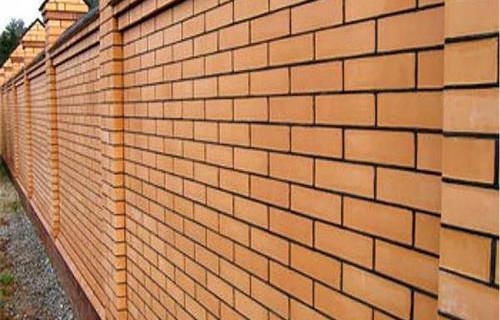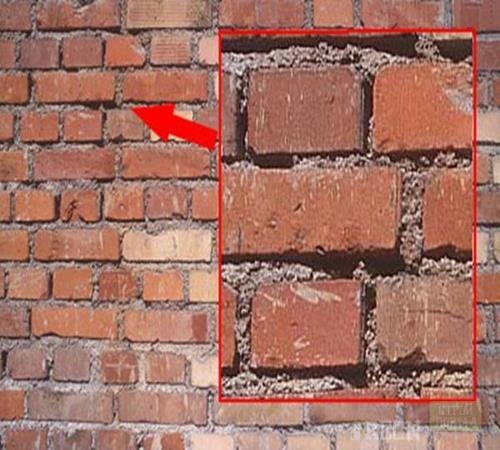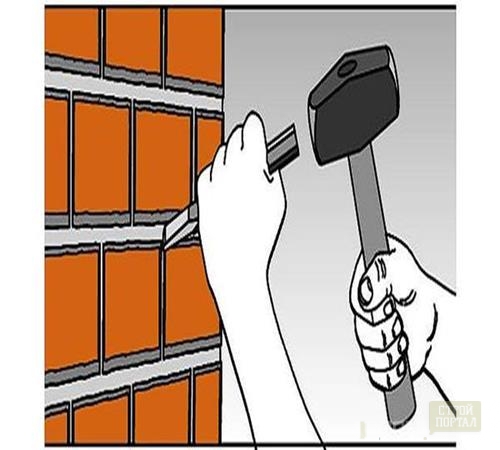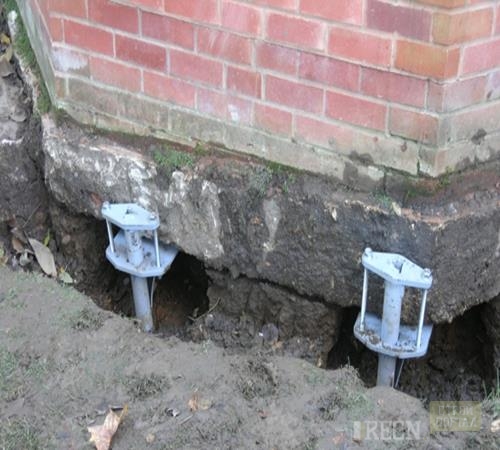
Repair of brick fence with your own hands Useful advice

The phenomenon of damage to a brick fence is rare enough. Often the root of manifestation of the problem lies at the initial stage of the construction, as a result of which, with time, defects and flaws, not corrected on time, can give a sad picture of the start of destruction of even a high-quality and expensive fence. Incorrect foundation or unprepared base under it also affects the durability of the constructed fence.
Content
Causes of problems resulting in repair
Despite its strength and durability (the service life of a qualitatively made fence is at least 25 years old) even in such a material, as a brick manifests signs of aging. Brick masonry under the influence of rains and winds, hot summer and frosty winter has a property with time to wind, cracks appear in the material. Not to mention the possibilities of damage to the integrity of the fence due to the effects of physical exertion. The main and first sign of the problem associated with the monolithium of the brick wall is the appearance of cracks on the surface. As a rule, they have small sizes and over time are not expanding, but it also happens that the crack can grow in size due to the impact of the load on this site and then it is necessary to produce a full repair of damaged.
There were several most common causes of defects, which subsequently and lead to the need for repair:
- The penetration of moisture inside the building material. This leads to the fact that during evaporation microcracks and pores in the brick are formed, which leads to the weakening of the structure and the further possibility of destruction.
- Improper waterproofing base. In the event that a waterproofing substrate was not laid between the foundation for a brick fence and its design, this is fraught with moisture in brickwork, which again leads to microcracks.
- The use of different brands and types of bricks. Some of the important elements can build out of the hollow brick that, with prolonged exposure to external factors and physical exertion leads to the appearance of cracks.
- Laying bricks unstable to extreme weather conditions. Such a reason is relevant where, for example, a standard brick brands that are not able to withstand low temperatures used against strong frosts.
- Not worked out foundation. This category includes an insufficient base thickness of the foundation, not an calculated degree of its freezing during the cold season and the absence of a necessary substrate layer from a graft mixture and sand.
Classification of cracks and methods to eliminate them
Nevertheless, there are ways to produce repair of a brick fence. We will analyze the main problems that can manifest themselves in brickwork over time:
- cracks in the material;
- mounted error when installing support pillars;
- incorrectly prepared foundation.
Since the most common problem was the appearance of cracks in brickwork, let's start with it. First of all, it is necessary to make sure that there are no such cracks in other places, that is, carefully examine the entire area of \u200b\u200bthe brick fence. The detected integrity defect should be labeled a peculiar beacon, covering the crack with a thin layer of cement mortar.
If a week later, the solution remains unharmed, then the crack is caused by the edge of the brick and does not need it in additional repair. But, in the case when fear or small cracks arise on the solution, more careful repairs should be carried out, since the reason has a mechanical origin and is associated, most likely, with errors made when installing the fence.
Cracks in brickwork belong to two categories:
- passive;
- active.
Passive cracks do not increase in length and width during a long period of time and appear as a result of the impact of the external environment without continuing the deformation. Such defects can be embedded by applying a cement solution over the damaged area, or the replacement of the cracked brick (if such an opportunity is feasible). It should be noted that in this case the crack seal solution should have the same basis and durability as the one that was used when the fence was built. If passive cracks are somewhat and their quantity does not increase, then such a repair of a brick fence will not take a lot of time and effort.
Active cracks create much more problems, as they tend to spread. In this case, it is necessary to initially determine the source of the problem and, if possible, localize it. Otherwise, the repair will be quite complicated and costs not only in time, but in price. Moreover, since often the source of the appearance of active cracks initially arose due to errors in the construction of the fence, it is recommended to refer to a specialist for the detection of a defect that led to the appearance of cracks.
In order to eliminate a similar problem, it is necessary first to find a point that creates the voltage and a greater degree of load on the fence, as a result of which new cracks appear. After that, it is embarks on the installation of a metal rod into a damaged masonry that will perform the role of the design support element. Following this, a thorough sealing of a damaged area should be made.
It should be noted that the stitching of the wall of the fence by metal only for a while holds the destruction of the brick. Therefore, it is necessary to correct the reason for the occurrence of excess load.
Fortunately, such a problem is mainly significant for old fences. Modern materials manufactured by all required technologies are exposed to cracks in rare cases and are usually subject to light repairs. Yes, and in old fences, the appearance of cracks often does not carry a fundamentally important nature - because the voltage will pass throughout the area of \u200b\u200bthe fence, and not only on separate elements. Nevertheless, if the problem has become significant, there are several methods for its solution, which will make the repair of the fence with their own hands.
We will again raise the types of damage by classifying them not only according to the degree of behavior, but also by the type of appearance:
- small non-separation cracks;
- large cracks in masonry, leading to the weakening of the overall design,
- cracks on the outer corner,
- serious damage to brick masonry.
Small cracks close easily and quickly. To do this, it is necessary with the help of a tool called "Scarpel" (a large chisel with a rigid wire welded to it) and the hammer to extend the cracks and its purification from dust and crumbs, followed by washing water. Then the purified surface is filled with a strong cement mortar and after drying can be coated from above the layer of insulating material, according to the color of the brick suitable. Such actions will help not only solve the problem, but also recreate the former aesthetic look of brickwork. Actually only for cracks, which showed their passivity as a result of observation (that is, there was no expansion fact that the size of a certain period of time) and the width of which does not exceed 4-8 mm.
Large cracks require more serious interference in the structure of the fence. In this case, it is necessary using a perforator to drill in the masonry the process hole in which a special tube for downloading the cement mortar is deeply inside. If the crack in the width reached threatening sizes (more than 10 mm), then there is a need for not only its expansion, followed by stripping, and in addition to this it will be necessary to replace cracked or damaged bricks. If the crack has a big length, use a special lock, which represents a segment of a steel strip or profile, which is attached to the wall with a dowel.
Since in the brick dowel is not fixed very well, then it must be described. For this, matches or wooden strips are used, they are inserted between the surface of the brick and dowel. This technology will fix the dowel very firmly and, unlike the anchor, does not hurt the brick.
A similar method will allow for a while to localize the source of the problem, but will add a significant disadvantage towards the exterior of a brick fence, which serves as a very good argument towards partial substitution of masonry.
Cracks on the outer corner are also a noticeable danger to the integrity of the design. In the event of cracks, it is recommended to use temporary measures in the form of metal linings to be used to strengthen the design, which must be hooked towards the wall. Such linings must be securely secured on the surface with a dowel. The article has a photo of brick fences, during the repair of which this method was used, which will clearly consider all the details.
With a significant degree of masonry damage, as well as when large cracks appear (more than 20 mm), it is advisable to make the wallsching wall. In fact, the bunch is the same brickwork, only with the difference that before starting work it is necessary to increase with the help of beams or crossbars part of the brick fence, which is located above, which will allow the wall to maintain stability with a partial analysis.
Repair of support pillars of brick fence
Another problem that is quite relevant for brick fences is a mistake made in the construction of support pillars, especially those who are attached to the gate. Such pillars have a metal rod inside their design. Usually it has several conclusions of the metal base on the surface of the reference pillar. This design is unreliable and can cause damage to the brick masonry and the further need of repair, and to eliminate this problem, you will need a complete dismantling of the post and the restructuring again, with the condition that part of the pipe (one of the parties) goes beyond the pillar. In order to avoid this, use a fairly simple way. It provides an installation of additional attachments for the gate and allows you to strengthen the design of a brick fence.
With this decision, it will take to dust the additional pipes deep into the ground (to a depth of at least 70 centimeters) and pour them with a mixture of rubble, cement, water and sand. These supports will need to be combined with a welding of another pipe, which will be held under the ground and gate and provide an additional support for the gate, which in the future will reduce the degree of load on this site.
If the destruction is no longer reversible and there is a need to redo the pillars, then it is advisable to install according to the specifications. Conditionally divide them for two options:
- pile type;
- linear type.
The pile type provides for the start of the masonry concreting of the metal base of the pillar into the ground. To do this, the pit of a depth of at least 1 meter is digging, then another 50-60 cm column is driven into the ground. The pit is poured with concrete or cement mortar. Such a base is reliably and withstands even significant mechanical loads (for example, a shock of a passenger car at a speed of 55-65 km / h).
An even more reliable method is called linear. The first part of the work is performed similarly to the pile technology, but in front of the pouring between the columns, they pump a ditch to a depth of 50 cm. Through it, they make another pipe, which is welded to each of the columns and creates an additional ribbon edge. Estimation for the repair of the fence according to the specified method, although it will be much larger than the simple concreting of columns, but it allows you to completely redistribute the load on the support poles, thus even with a bad foundation, the occurrence of the resonant load is excluded.
Repair foundation
It is much worse if the reason for the appearance of cracks was the deformation caused by the shrinkage of the foundation. The reasons for shrinkage can be quite a lot:
- improper depth;
- insufficient width;
- lack of drainage;
- low-quality fill;
- failure to comply with the technology of construction of monolithic structures.
But whatever the reason, the result will appear in the form of cracks. At the same time, the location is simple enough, as the fence will begin to fake. If visually find the lower part of the arc is difficult, use the level.
Having revealed a problem area, the problem should be eliminated. By and large, bad foundation is impractical, as it will collapse, no matter how much you try to save it. Therefore, the manifestation of such defects is fraught with the intelligence of the entire fence, including the foundation.
As a temporary phenomenon, piles are used, or rather determined by their analogue. It will take to cook from the chawller framework, in shape resembling the letter "P". Its flat part is a support for the destroying foundation, and the lower edges rest in the ground. Long supports should be at least 20 cm. This will significantly slow down the shrinkage process.
There is no sense to fill the concrete, as it will create a resonance in the design and will redistribute the load on the foundation, as a result - the shrinkage will occur even faster. It is worth noting that in spite of all the difficulties of the repair work, the fence brick is much easier to renovate than shifting completely.

























